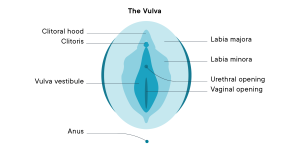It’s strange that most can’t distinguish between vulva and vagina. “Isn’t vulva the same as vagina?”, “Where is what?” “What are labia?” “Is the clitoris the same as the penis?” . If you have questions like these too, that’s perfectly okay – in school, we’re only given a limited explanation of all this.
What actually is a vulva?
In the past, it was often said that the generally accepted term for the female sexual organ was vagina. Today, many people also say vagina, meaning everything that belongs to it. But this is not correct and does not do justice to this region.
While vagina has become the accepted term for the female genitalia (excluding, of course, many icky terms we won’t quote here), vulva is actually the correct term for all the external organs, including the mons pubis, the labia majora and minora, the all-important clitoris, the external openings of the urethra, and the vagina.
In other words, it denotes everything.
Um ok, then what is (m)a vagina?

The vagina is the muscular space that connects the uterus to the vulva. It’s through it that babies come into the world during birth or a woman’s menstrual flow comes out.
Here’s why you should differentiate between the two terms:
By referring to a woman’s entire anatomy as the ‘vagina,’ we are referring to our sexual organs, with the part that gives heterosexual men the most pleasure.
However, most women like and need clitoral stimulation to reach orgasm. So using the right terminology can also serve as education and help raise awareness about women’s sexual pleasure.
On an even more basic level, knowing the specific and correct terms for body parts empowers women to take full responsibility for them and talk about them openly. And that can’t happen if we lump everything together.




